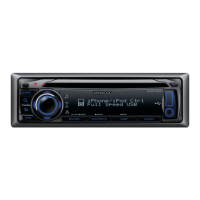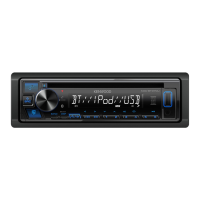
Do you have a question about the Kenwood KMR-555U and is the answer not in the manual?
| Brand | Kenwood |
|---|---|
| Model | KMR-555U |
| Category | Car Receiver |
| Language | English |
Initial setup instructions for the unit before first use.
Procedure for cleaning unit connectors to ensure proper function.
Information on moisture buildup and its effect on disc playback.
Steps to restore unit to factory settings if it malfunctions.
General remarks and important information regarding usage and accessories.
Technical specifications for the FM tuner function.
Technical specs for the digital FM tuner for specific models.
Technical specifications for the AM tuner function.
Technical specs for the digital AM tuner for specific models.
Technical specifications related to the CD player functionality.
Steps to disable the initial demonstration mode on the unit.
Instructions on how to remove and reattach the unit's faceplate.
Instructions for turning the unit's power on and off.
How to choose and switch between different audio sources.
Basic operation for adjusting audio volume.
Information on connecting USB devices to the unit.
Details on connecting external audio devices via auxiliary input.
Instructions on how to search for specific songs within the music library.
Information on how titles display when characters are not supported.
Requirements for using Pandora with Apple devices.
Requirements for using Pandora with Android devices.
Requirements for using Pandora with BlackBerry devices.
General notes and important considerations for Pandora service.
Instructions for listening to Pandora with Android/BlackBerry devices.
Instructions for listening to Pandora with iPhone/iPod touch.
Steps for creating a new station when "My Station" is chosen.
Steps for creating a new station when "Genre" is chosen.
Requirements for using Aha Radio with Apple devices.
Requirements for using Aha Radio with Android devices.
General notes and important considerations for Aha Radio service.
Instructions for listening to Aha Radio with Android devices.
Instructions for listening to Aha Radio with iPhone/iPod touch.
Requirements for using iHeartRADIO with Apple devices.
Requirements for using iHeartRADIO with Android devices.
General notes and important considerations for iHeartRADIO service.
Instructions for listening to iHeartRADIO with Android devices.
Instructions for listening to iHeartRADIO with iPhone/iPod touch.
Instructions for searching music files from audio sources.
Instructions for searching music from CD sources.
Lists the supported audio file formats for playback.
Information on compatible disc types for playback.
Details on supported file formats for discs.
Lists the types of USB devices supported by the unit.
Supported file systems for USB devices.
Explains the order in which audio files are played.
Defines the term "USB device" as used in the manual.
Lists disc types that are incompatible with the unit.
Explains Program Service Data features of HD Radio.
Describes the HD2/HD3 channels in HD Radio broadcasts.
Highlights the digital audio quality of HD Radio.
Explains the iTunes tagging feature for HD Radio content.
Guide on how to utilize the iTunes tagging feature.
Important notes during the TAG storing process.
Information on the limit for stored song information tags.
How to configure iTunes tagging settings.
Steps required before using the iTunes tagging function.
Setting for IF Band to optimize tuner selectivity and sound quality.
Configuration options for station seek mode.
Setting for HD Radio receive mode (Auto, Digital, Analog).
Displays memory usage for HD Radio and SiriusXM tag functions.
Option to enable/disable iTunes tag memory for HD Radio.
Sets the side part display for Types A, B, and D.
Configures the Type D Spectrum analysis display.
Sets the status display (ON/OFF indicator) for Types A and B.
Allows selection of illumination color for all parts of the panel.
Allows selection of illumination color for the display part.
Allows selection of illumination color for the buttons.
Sets text display content for audio files and iPods.
Sets text display content for Pandora source.
Sets text display content for iHeartRADIO source.
Sets text display content for CD source.
Sets text display content for HD Radio tuner.
Sets text display content for Tuner source.
Sets text display content for Bluetooth audio source.
Sets text display content for Auxiliary input source.
Sets text display content when the unit is on Standby.
Sets text display content for SiriusXM source.
Controls turning off display and key illumination when Display Type E is selected.
Adjusts display brightness in sync with vehicle's light switch or manually.
Adjusts the contrast level of the display.
Switches panel display between positive and negative modes.
Sets the method for scrolling hidden text on the display.
Displays cell phone connection status, signal strength, and battery level.
Adjusts key illumination brightness manually or with the light switch.
Controls whether key illumination changes with key operation.
Sets whether key illumination color changes with sound volume.
Synchronizes unit's clock with radio data system time.
Sets the date display mode, offering 7 types.
Configures the source selection method for the SRC button.
Enables or disables the operation check sound (beep).
Changes the display language in the Function setting mode.
Controls the visibility of Pandora during source selection.
Controls the visibility of iHeartRADIO during source selection.
Controls the visibility of Aha Radio during source selection.
Controls the visibility of the built-in AUX source.
Sets the method for reading CDs, including force playing.
Selects which iPod receives iTunes tags when two are connected.
Turns off the built-in amplifier to improve preout sound quality.
Optimizes System Q value based on speaker type.
Instructions for upgrading the unit's firmware.
States the Bluetooth version supported by the unit.
Lists the supported Bluetooth profiles (HFP, SPP, etc.).
General notes on Bluetooth compatibility and functionality.
Option to call back an incoming number from the call log.
Option to call back an outgoing number from the call log.
Option to call back a missed call from the call log.
Automatically answers calls after a preset time interval.
Starts re-pairing with a device automatically when unpaired.
Enables Apple Auto Pairing for automatic iPod/iPhone registration.
Specifies output speakers for hands-free and audio.
Sets whether a beep is output when a call comes in.
Adjusts microphone sensitivity for calls or caller's voice.
Sets the echo cancellation level for calls.
Instructions on how to find and record the SiriusXM Radio ID.
Steps to activate the SiriusXM service and tuner.
Steps to select the SiriusXM tuner as the audio source.
How to select a specific SiriusXM channel.
Options for changing the seek mode for SiriusXM channels.
Instructions for storing SiriusXM channels into memory.
How to recall stored SiriusXM stations.
Information about the Smart Favorites feature for SiriusXM.
How to effectively use iTunes tagging information.
Important notes during the TAG storing process.
Information on the storage limit for song information tags.
How to configure iTunes tagging settings.
Steps required before using the iTunes tagging function.
How to register songs or artists for alerts.
Information on the storage limit for content alerts.
How the unit behaves when a content alert occurs.
Conditions under which content alerts may not be displayed.
How to exit the content alert mode.
Option to delete registered song alert items.
Option to delete registered artist alert items.
Option to delete all registered content alert items.
Sets the seek mode for SiriusXM channels.
Turns the Tune Start function on or off.
Displays the received signal strength of the SiriusXM tuner.
Displays memory usage for the SiriusXM Replay function.
Displays tag memory usage for HD Radio and SiriusXM tuners.
Turns the iTunes tag memory function for SiriusXM tuner on or off.
Initial preparation steps for the remote control unit.
Instructions for replacing the remote control's battery.
Safety precautions regarding battery handling and remote control usage.
Basic controls applicable to the remote unit.
Notes on powering on the unit via the remote.
Basic remote operations for the Tuner source.
Basic remote operations for HD Radio tuner source.
Basic remote operations for CD/Audio file sources.
Troubleshooting for display setup issues, possibly due to demo mode.
Troubleshooting for display selection options, possibly due to display type.
Troubleshooting for issues with equalizer settings.
Troubleshooting for Bass Boost setting problems.
Troubleshooting for Sound Enhancements setting issues.
Troubleshooting for Position control setting problems.
Troubleshooting for Loudness setting issues.
Troubleshooting for DSP Set issues, potentially related to disabled DSP function.
Troubleshooting for general operation or wiring errors.
Troubleshooting for poor radio reception.
Troubleshooting for issues with disc playback.
Troubleshooting for sound skipping during audio file playback.
Troubleshooting for inability to select iHeartRADIO stations.












